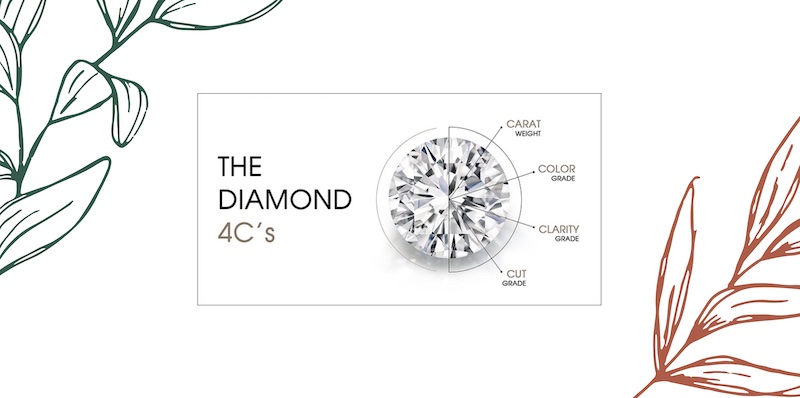
Diamonds, the epitome of elegance and luxury, have captivated hearts for centuries. But behind their mesmerizing beauty lies a precise system of grading known as the 4Cs. From clarity to carat, each ‘C’ holds the key to unlocking the brilliance of these precious stones. So, let’s embark on a journey to delve deeper into the realm of the diamond 4Cs chart.
Clarity: The First C
When we talk about clarity in diamonds, we’re referring to the absence of internal flaws or inclusions. These imperfections, although natural, can affect a lab made diamonds and overall appearance. The clarity grade, ranging from Flawless to Included, provides insight into a diamond’s purity. Think of it as looking through a clear window versus a slightly foggy one – the clearer the diamond, the more light can pass through, resulting in heightened sparkle and shine.
Color: The Second C
Contrary to popular belief, diamonds come in an array of colors, from icy whites to rich yellows and even rare pinks and blues. The color grade assesses the absence of color in a diamond, with D being the highest grade (colorless) and Z indicating noticeable color. While colorless diamonds are highly coveted for their purity, some prefer the warmth and character of slightly colored stones, making color grading a matter of personal preference.
Cut: The Third C
Arguably the most critical aspect of a diamond’s beauty, the cut determines its ability to reflect and refract light. A well-cut diamond will showcase optimal brilliance and fire, while a poorly cut one may appear dull and lifeless. From classic round brilliants to fancy shapes like princess and emerald cuts, each cut style has its unique charm and impact on a diamond’s appearance. It’s akin to the precision of a master sculptor shaping a block of marble into a masterpiece – the cut unleashes the diamond’s true potential.
Carat: The Fourth C
Carat weight, often misconstrued as size, diamond 4cs chart, actually refers to the weight of a diamond. While larger diamonds generally command higher prices, it’s essential to strike a balance between carat weight and the other Cs. A smaller diamond with excellent cut, color, and clarity can outshine a larger but inferior stone. It’s like comparing a petite yet impeccably tailored dress to a voluminous gown that lacks refinement – size isn’t everything when it comes to diamonds.
Comparing Diamond Qualities
Understanding the 4Cs is not about isolating each aspect but rather recognizing how they interact to determine a diamond’s overall quality. A diamond with flawless clarity may still appear lackluster if its cut is subpar, highlighting the importance of finding harmony among the 4Cs. It’s akin to composing a symphony where every instrument plays its part to create a harmonious melody – each ‘note’ contributes to the diamond’s brilliance.
Choosing the Perfect Diamond
Selecting the perfect diamond involves considering various factors, including budget, personal style, and intended use. Whether you’re opting for a dazzling engagement ring or a timeless pendant, diamond 4cs chart, knowing what to look for can make the selection process smoother. Remember to prioritize what matters most to you – whether it’s size, sparkle, or symbolism – and don’t hesitate to seek guidance from reputable jewelers.
Common Misconceptions about Diamond Grading
In a world filled with myths and misconceptions, it’s essential to separate fact from fiction when it comes to diamond grading. From beliefs that bigger is always better to assumptions about flawless diamonds being flawless in every sense, debunking these myths can help consumers make informed decisions. After all, knowledge is the ultimate gem that shines brightest in the light of truth.
The Evolution of Diamond Grading
Diamond grading has come a long way since its inception, evolving alongside advancements in technology and industry standards. From the early days of basic color and clarity assessments to today’s sophisticated grading methodologies, the journey has been one of continuous improvement and innovation. With each leap forward, the quest for precision and accuracy in diamond evaluation has reached new heights.
The Impact of Technology on Diamond Evaluation
Technology has revolutionized the diamond industry, providing gemologists with powerful tools to analyze and assess diamonds with unparalleled precision. From high-tech imaging systems to advanced spectroscopy techniques, these innovations have elevated the art of diamond grading to unprecedented levels of accuracy. It’s like upgrading from a magnifying glass to a state-of-the-art microscope – the finer details become crystal clear, enabling gemologists to uncover the true beauty of each diamond.
Ethical Considerations in Diamond Grading
Beyond the 4Cs, ethical considerations play a significant role in diamond grading and purchasing decisions. Consumers are increasingly mindful of the environmental and social impact of diamond mining, prompting the industry to adopt ethical sourcing practices and transparent supply chains. Certifications such as the Kimberley Process Certification Scheme and initiatives promoting fair labor practices help ensure that diamonds are not only beautiful but also ethically sourced.
Emerging Trends in Diamond Preferences
As society evolves, so do preferences in diamond aesthetics and design. From vintage-inspired settings to minimalist chic, trends come and go, reflecting shifting tastes and cultural influences. Whether it’s a preference for lab-grown diamonds over mined ones or a resurgence of interest in classic designs, keeping abreast of emerging trends can inspire fresh perspectives on diamond selection and design.

